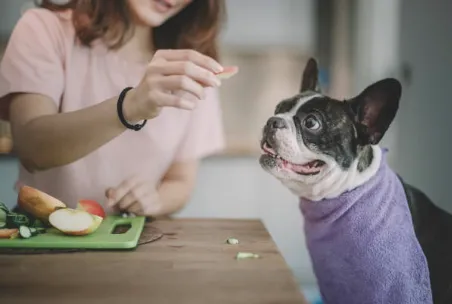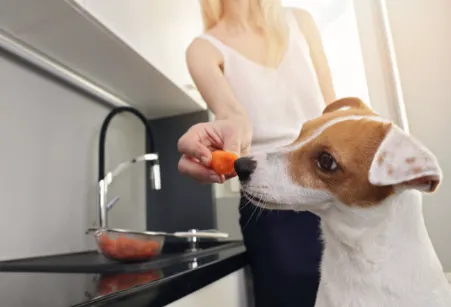Choosing the right snacks for your beloved canine companion is crucial for their health and happiness. With so many options available, both commercial and homemade, many dog owners find themselves asking: What Is The Best Snack For Dogs that is both delicious and nutritious? It’s easy to reach for a store-bought treat, but did you know that many everyday fruits and vegetables from your own kitchen can be excellent, healthy snack alternatives? Not only do they offer a burst of vitamins and minerals, but they also provide a natural, low-calorie option to supplement your dog’s diet. This guide from Dog Care Story will explore a variety of safe and beneficial human foods that make fantastic treats for your dog, along with important considerations to ensure their well-being.
Why Choose Healthy Snacks for Your Dog?
Incorporating healthy snacks into your dog’s diet offers numerous benefits beyond just satisfying their cravings. These treats can be excellent for managing weight, providing essential nutrients, promoting dental health through chewing, and even aiding in training. Unlike many processed dog treats, natural fruits and vegetables are often low in calories, fat, and artificial additives, making them a smart choice for dogs of all ages, especially those needing to watch their waistline or with dietary sensitivities. Providing appropriate treats can also be a wonderful way to strengthen the bond with your pet and enrich their daily life.
Top Fruits Your Dog Can Enjoy
Fruits can be a sweet and refreshing treat for your dog, packed with beneficial vitamins and antioxidants. Remember to always prepare them properly before serving.
Apples
Apples are a fantastic choice, rich in vitamins A and C, and a good source of fiber. Their low protein and fat content make them particularly suitable for senior dogs. Always remove the seeds and core, as apple seeds contain small amounts of cyanide and the core can be a choking hazard. Sliced apples make a great crunchy snack, or you can try making baked apple chips for a special homemade delight.
Bananas
While delicious, bananas should be given in moderation due to their high sugar content, making them more of a special treat than a daily staple. Despite the sugar, they are packed with potassium, vitamins (especially B6 and C), biotin, fiber, and copper, offering a great nutritional boost. A few slices of banana can be a delightful and energy-boosting reward. For a fun twist, consider making your own banana and peanut butter dog treats at home.
Blueberries
Often hailed as a superfood for humans, blueberries offer similar benefits to dogs. They are loaded with antioxidants and vitamins, which can help support overall canine health. Their small size makes them perfect for training rewards or for tossing in the air for a fun game of catch. You can mix them into plain yogurt for a creamy snack or follow this easy dog biscuit recipe to create homemade blueberry treats.
Wholesome Vegetables for Canine Companions
Many vegetables are excellent, low-calorie options that provide essential nutrients without excess fat or sugar.
 A vibrant assortment of dog-friendly fruits and vegetables, including apples, bananas, and blueberries, displayed in a woven basket.
A vibrant assortment of dog-friendly fruits and vegetables, including apples, bananas, and blueberries, displayed in a woven basket.
Cucumbers
Cucumbers are an outstanding snack, especially for dogs needing to lose weight, due to their extremely low carbohydrate and fat content. They are also an excellent source of hydration and contain vitamins K, C, and B1, along with potassium, copper, magnesium, and biotin. Sliced cucumbers can be a refreshing treat, or you can freeze them for a fun, enriching snack during warmer months.
Pumpkin
Pumpkin is highly beneficial for dogs, particularly those with sensitive stomachs, thanks to its high fiber content and antioxidants. It can help regulate digestion and alleviate both constipation and diarrhea. If using canned pumpkin, always ensure it is 100% pure pumpkin puree, not pumpkin pie filling which contains spices and sugar that are harmful to dogs. Alternatively, you can roast and peel fresh pumpkins for a tasty, natural treat. Explore some great pumpkin treat recipes to create homemade goodies.
Carrots
Yes, dogs can definitely eat carrots! These crunchy root vegetables are a fantastic low-calorie snack that can help your dog feel fuller for longer, making them a great addition to a weight management plan. Carrots are rich in fiber and beta-carotene, which is converted to Vitamin A in the body, promoting good vision and immune function. The firm texture also provides a natural toothbrush effect, aiding in dental hygiene.
Important Considerations When Giving Human Snacks
While many human foods are safe, responsible pet ownership means understanding how to offer them correctly. Always introduce new foods slowly and in small quantities to monitor for any adverse reactions. If your dog experiences a sudden change in energy levels or seems to be having trouble healing a ripped paw pad, it’s always best to consult with your veterinarian.
Moderation is Key
Even healthy snacks should be given in moderation. Treats should not make up more than 10% of your dog’s daily caloric intake to prevent nutritional imbalances and weight gain. Over-feeding any treat, no matter how healthy, can lead to digestive upset or contribute to obesity.
Preparation Matters
Always wash fruits and vegetables thoroughly. Remove seeds, pits, and cores from fruits like apples and peaches, as these can be choking hazards or contain toxic compounds. For some vegetables, cooking might be necessary to aid digestion, though many can be given raw. Always cut food into bite-sized pieces appropriate for your dog’s size to prevent choking. If you notice your dog struggling with a chew or showing signs of discomfort in their paws after a vigorous chewing session, you might want to consider alternatives or check for issues like how to treat a dog’s split paw pad.
Allergies and Sensitivities
Just like humans, dogs can have allergies or sensitivities to certain foods. If you observe any symptoms like itching, vomiting, diarrhea, or unusual behavior after introducing a new snack, discontinue it immediately and consult your veterinarian. Early detection and understanding how to heal a dog’s split pad or other minor injuries are part of responsible pet care.
Consult Your Vet
Before making any significant changes to your dog’s diet, or if you have any concerns about specific foods, always consult with your veterinarian. They can provide personalized advice based on your dog’s breed, age, health status, and specific dietary needs. This proactive approach helps ensure your dog receives the most appropriate and beneficial nutrition. For instance, if you’re exploring long lasting dog chews for large dogs, your vet can advise on the safest and most effective options. Keeping an eye on their paw health, and knowing how to treat a torn paw pad on dog is also vital for active dogs.
Foods Your Dog Should Never Eat
While a variety of human foods are safe for dogs, many others are highly toxic and should be avoided at all costs. Being aware of these dangers is just as important as knowing what healthy options exist.
 A small Jack Russell dog eagerly sniffs a healthy carrot treat offered by a person, illustrating safe and nutritious human food for dogs.
A small Jack Russell dog eagerly sniffs a healthy carrot treat offered by a person, illustrating safe and nutritious human food for dogs.
Some of the most dangerous foods for dogs include:
- Grapes and Raisins: Can cause acute kidney failure, even in small amounts.
- Onions and Garlic: Belonging to the Allium family, these can cause damage to red blood cells, leading to anemia.
- Chocolate: Contains theobromine, which dogs metabolize slowly, leading to toxic build-up affecting the heart and nervous system.
- Avocado: Contains persin, which can cause vomiting and diarrhea in some dogs. The pit is also a choking hazard.
- Xylitol: A common artificial sweetener found in many sugar-free products (gum, candies, peanut butter), it can cause a rapid and dangerous drop in blood sugar and liver failure.
- Alcohol and Caffeine: Highly toxic to dogs, affecting their nervous system and heart.
- Fatty and Salty Foods: Can lead to pancreatitis, digestive upset, or sodium ion poisoning.
- Bones (cooked): Cooked bones can splinter and cause internal damage or blockages. Raw bones carry risks of bacterial contamination.
Always keep these and other potentially harmful foods out of your dog’s reach. If your dog ingests any of these items, contact your veterinarian or an emergency animal hospital immediately. Knowing how to heal a ripped paw pad is one thing, but preventing internal poisoning is paramount.
Conclusion
Finding what is the best snack for dogs truly comes down to understanding what is safe, nutritious, and enjoyable for your individual pet. By incorporating healthy fruits and vegetables from your own kitchen, you can offer your canine companion a delightful variety of natural, wholesome treats. Remember to always prioritize their health by offering snacks in moderation, preparing them correctly, and being mindful of any potential allergies. Always consult with your veterinarian before making significant dietary changes, especially if your dog has existing health conditions. Your dedication to providing healthy snacks contributes significantly to your dog’s overall well-being and a long, happy life together. For more helpful tips and recipes, explore other articles on Dog Care Story!
References
- American Veterinary Medical Association (AVMA). (n.d.). Food Safety for Pets. Retrieved from https://www.avma.org/
- American Kennel Club (AKC). (n.d.). Dog Nutrition. Retrieved from https://www.akc.org/
- Pet Poison Helpline. (n.d.). Top 10 Pet Poisons. Retrieved from https://www.petpoisonhelpline.com/
- Tufts University Cummings School of Veterinary Medicine. (n.d.). Clinical Nutrition Service. Retrieved from https://vetmed.tufts.edu/
